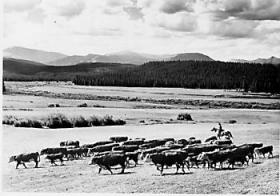The principal population centers in the Fraser River Valley are Winter Park, Fraser and Tabernash. When the early stage coaches came over Berthoud pass into the Fraser Valley, the most popular stop was at the Cozens Ranch, which now houses a historical museum in Winter Park. The valley is now bisected by U.S. Highway 40, which was designated the "Victory Highway" in 1931. The new route of the highway leads through the main streets in both Fraser and Tabernash and the backdoors of some business became front doors because of the new highway alignment.
Tabernash was the name given to a railroad siding, named for the Ute leader who was killed during a confrontation with local ranchers. The town became a key station on the railroad line, and included a roundhouse, and a supply of helper engines for the steep climb over Rollins Pass. When the Moffatt Tunnel was opened in 1928, the railroad no longer needed service there and the town lost its' main economic support.
George Easton founded the town site of Fraser in 1905. The rest of the country became familiar with Fraser when the winter temperatures were often the lowest recorded in the U.S. and Fraser was know by the nickname "Icebox of the Nation". Lumbering was one of the prime industries in the region until World War II. During the war, the military built a Prisoner of War camp at Fraser to help lumber for the mills in the area.
The current area of Winter Park has had many names over the years. First it was called simply "Old Town" or "Vasquez", named after the fur trader Louis Vasquez. "Woodspur" or "Woodstock" referred to Billy Wood's lumber mill in the area, which furnished ties for the railroad while it was being built over Rollins Pass. During the construction of the Moffatt Tunnel, the name "West Portal" came into usage. Rail workers also called the community "Little Chicago" as it was as it was a favorite gambling, saloon, and brothel site. As tourists began to arrive it was known as "Idlewild" and also "Hideaway Park". Finally, the name "Winter Park" was settled upon to correspond with the adjacent ski area of the same name.
The area population declined from 1232 people in the 1920's to only 373 people by 1930. The Great Depression ended the construction boom and the price of beef became too low for ranches to turn a profit. However, since that time, the area has thrived, mostly based on a tourism economy. The valley's main source of income is now recreation and second home construction.
Abbott Fay, To Think That This Happened in Grand County!, Grand County Historical Association, 1999
Ranch Creek and its' Tributaries from the Divide to the Valleys, Grand County Historical Association journal, Vol VII, No 1, 1988
Robert Peterson, Fraser Valley Memories, self published, 2002









